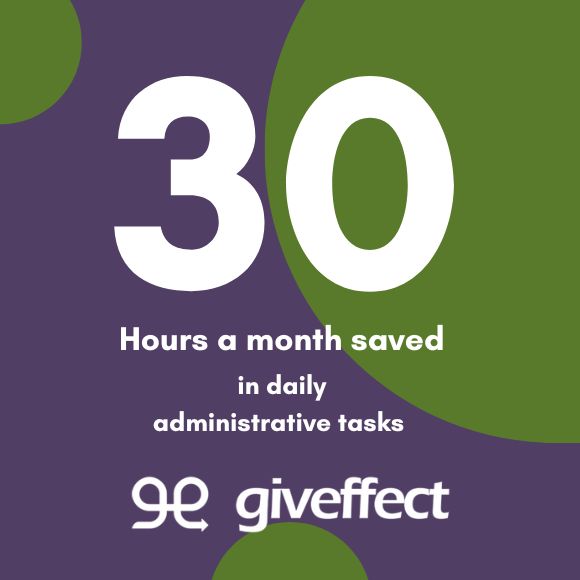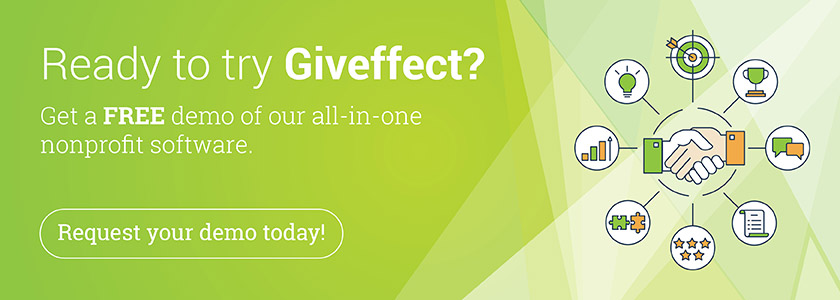Most nonprofit professionals would agree that there are never enough hours in the day, days in the week, or resources available to make as big of an impact as they strive to achieve. One way to give your team back time and resources is to put your tech to work for you with workflow automation.
Let’s take a look at:
- What is nonprofit workflow automation?
- How to apply
- How Giveffect can help.
What is nonprofit workflow automation?
Workflow automation is a technology that automates time-consuming manual work. Within a CRM such as Giveffect, workflows or step-by-step series of tasks are set up and layered with rule-based logic. Once triggered, the system completes the series of tasks without human intervention.
Workflow automation is incredibly helpful in completing manual and repetitive tasks. This frees up your team’s time, volunteers, and other resources to focus on other projects to achieve goals. Workflow automation can help nonprofits achieve more with less.
How to apply:
Don’t waste time on tasks you can automate. Workflow automation can be used on anything from sending emails to managing constituent data.
Of course, this can take on many different tasks at different levels. One example of a simple workflow automation is the automated out-of-office email response. Every working professional is familiar with this one.
When you are out of the office for vacation or a conference, you likely won’t be spending your time responding to emails in a timely manner or at all. So ahead of being away, set up what is commonly referred to as an out-of-office message. you would typically add a rule to your email client (gmail or outlook) that states something like between this date and that date, automatically respond with this message. As a result, when you receive an email during that time period, that email is the triggering event. The next step in the workflow automation is that your email system automatically responds back with your pre-set message. That’s it!
An automated out-of-office email message while you are out of the office is one small way to automate your work, so you don’t have to reply while you are on vacation.
Ways you might like to use Workflows Automation within a Nonprofit
You can automate emails, text messages, tasks, and more, all a part of a list of automated processes.
The workflow feature within Giveffect was created to help define and automate your processes based on specific supporter actions. Being able to automate some of your processes will cut down on the time you spend pulling reports, manually entering tasks, or sending emails.
Let’s dive into one specific example: you can create an automatic workflow to send emails to all of your donors on their birthdays. Step one would be to capture donor birthdays on your donor profiles within your CRM. Step two would be to craft a special birthday message that you would like your donors to receive. (Of course, you can add fields for personalization!) Step three would be to login
Additional ideas for tasks you can complete with workflow automation:
- A new supporter Welcome Email Series.
- Customized alerts and thank-you sequence for first-time donors, donations greater than $1,000, or donations from a specific Group.
- Automated Birthday, Donorversary, Volunteerversary appreciation emails.
- When a volunteer checks in
- When tickets are scanned at an event.
And you can create a process that can send a second email if they didn’t open it. Or a different email if they did open it.
Many nonprofits are automating fundraising replies for new donors that create a smart “funnel” for other nonprofit positions.
For example, a new donor may have a grandmother who had a heart issue. They may want to give back and find a nonprofit that helps people with heart problems. So they visit the website of the nonprofit for the first time, click on the donate button and make their quick donation, and get back to their busy day.
Now, in an automated system, it will receive that donation on the back end, and it will automatically send a “thank you for donating” email which can include a receipt for the donation. But that may be only the first step in the nonprofit workflow automation process.
Schedule a follow-up email for a week after the first donation to ask key questions to gauge possible further involvement. The email can ask if the donor has any interest in setting up a donation schedule, volunteering, attending events, or interest in news and announcements from the nonprofit.
And you can automate the replies to those emails to trigger other emails that give more details about any area they want more information. If the original email wasn’t open within a specific time period, trigger to resend this email again, perhaps slightly altered.
Workflows can be both automated and dynamic based on how the rules are set up to coincide with the actions of your audience. You write and design all the emails one time, set up the process, and turn it on.
How Giveffect can help with nonprofit workflow automation?
It perhaps sounds too good to be true. A system that can do the busy work for me? And even if it exists, it would need a team of IT professionals to manage it.
Designed to be user-friendly, Giveffect puts the power of nonprofit workflow automation into your staff’s hands at any level of nonprofit. And if you need more support, the Giveffect Customer Success team is available to help guide you through the process with training, how-to videos, and support articles.
The more your team automates, the more time they can do what they and you love, working with clients in the community.
In fact, Giveffect clients report 30 hours saved per month on daily administrative tasks through nonprofit workflow automation.

How Giveffect functions with workflow automation.
Now you can set up entire drip or funnel streams for your marketing, including emails, text messages, tasks, and more.
For instance, this system will allow you to create an automated email, then based on the client’s actions, if they open the email or not, you can set the second set of scheduled automated actions. If they open the email, you can follow up with a text message in a few days. But if they don’t open the email, you can set a task for an employee to personally touch base the next week.
The workflow can continue on with multiple paths based on the client’s continued actions, including multiple emails, text messages, tasks, and more.
This “drip” allows you to set up an entire workflow one time and it can be carried out for weeks or months automatically. Which saves you and your staff time. Set it once and forget it.
See the nonprofit workflow automation in action:
A quick look at other ways Giveffect can help with automation
- A native all-in-one system to make sure everyone is on the same page.
- Automation to automatically complete small tasks. An all-in-one system to run quick reports.
- Modern templates to make emails and event pages look great will minimal effort.
Native all-in-one system
Giveffect was designed to be a complete system for nonprofits from the very beginning. This is a system that would natively work with donors, fundraisers, volunteers, events and event staff, members clients, and more. All in one nonprofit software. All in the same system.
It allows you to have all of these options, from complex reporting to emails, to text messages, to automated workflows. So you can save all staff members time.
Small tasks:
Specific tasks are automated from the start in Giveffect. For example, if someone makes an online donation, they automatically receive an emailed receipt.
For first-time donors who have had no prior experience with your nonprofit, as soon as he or she donates, the system creates a profile for that person and adds the donation to the newly created profile. Then it automatically sends the receipt.
And the system also automatically checks if the donor already has a profile, using the information provided in the donation process. If they are in the system, then the donation is added to their existing profile, along with any other donations, volunteering, memberships, events attended, fundraisers hosted, and more. And of course, the receipt is automatically sent. You don’t need to worry about duplicate records.
In addition, you can always track that donation by name and resend the receipt with the press of a button if it is ever requested by the donor.
But that’s just one example. You can also automatically sync emails, use batch scanning and remote deposits, schedule and reschedule volunteers, schedule emails, payments, reminders, and much more. Giveffect can even work with your nonprofit to automate unique systems that you may have. For example, how Giveffect has a system to automate “sweat equity” hours for Habitat for Humanity chapters.
Quick reports:
We have already discussed how all the systems are in one place in Giveffect. This means that you can run all of your reports in one place.
No need to import or export data in and out of other systems to run cross-referenced reports, saving you time.
If you want to run a report on how many of your volunteers donated this month? Easy. Set up a few fields and find out! Your volunteer list and your donor list are in one place. No cleaning of data. No reformatting.
That can save massive amounts of worker time and money. Also, it makes it far easier to run more reports that can dig even deeper into questions that you may not have had the manpower to even address in the past.
You can create reports based on age, location, and more; cross-reference them by donations, events, volunteering, memberships, or all four. Each report could have taken hours to create in a prior system, and takes only a few minutes now.
Members in every department can have access to as much of the system as you decide. And the speed of the reports means that your staff has more time to be in the field working with clients or potential donors.
Modern templates to make emails and event pages look great:
Beyond the internal discussions and reports, the public perception of your nonprofit is critical. And many nonprofits don’t have the budget to hire expensive designers. But Giveffect features modern templates that use “what you see is what you get” design that allows anyone to put together a nice email or event in a matter of minutes.
And as all your contacts are in the system, no need for uploading or downloading client lists into a separate email or event page system.
This allows you and your staff to send out emails that can be easily tailored to many different audiences, to have a larger, more direct impact. For example, you may have a monthly email, but you can use a volunteer story at the top for volunteers, and a donor story at the top of the email to donors.
Instantly make changes or updates. No third party or another team to wait on. Edit and send emails and pages on your schedule.
These systems can save you and your staff hours a month creating emails and pages, allowing everyone to do work more critical to your cause.
Again, on average Giveffect saves clients 30 hours a month in daily administrative tasks. See for yourself in a free demo, and set workflow automation in 14 days trial.

More on automation:
Marketing Automation: Share Your Story With Ease
Workflow automation can help your nonprofit’s labor problems
Giveffect Features: Workflow Automation System